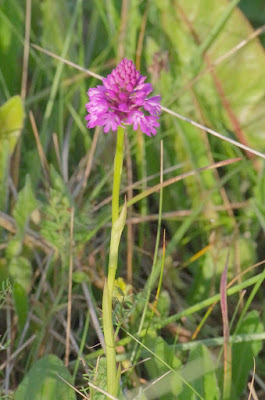Our main reason for wanting to fit in a visit was to search for the Lindisfarne Helleborine, a species of orchid that occurs nowhere else in the world! Sad to say, despite a four mile trudge around the dunes and dune slacks, we never managed to locate the wire-mesh 'cages' that protect these easily-overlooked plants from rabbits.
There were plenty of other things to enjoy, however: almost the first flower we saw was a patch of Bloody Cranesbill, the county flower of Northumberland. Northern Marsh Orchids, Purple Spotted Orchids and Pyramidial Orchids were all abundant, and Marsh Helleborines grew in numbers in every boggy hollow. Also of interest were beautiful carpets of pink Restharrow, a member of the pea family with large, pink flowers resembling Sweet Peas. In among these were the curious seed heads of an invasive alien, the Piri Piri Burr. Originally from New Zealand, the hooked seeds cling to anything they touch and Brian and I spent some time 'decontaminating' before getting back in the car!
During our short trip to the North East we didn't come across many insects, so it was pleasant to encounter a Dark Green Fritillary on Lindisfarne, while the colourful flower spikes of Viper's Bugloss attracted Six-spot Burnet Moths. Other butterflies included Small Heath and Ringlet.















No comments:
Post a Comment